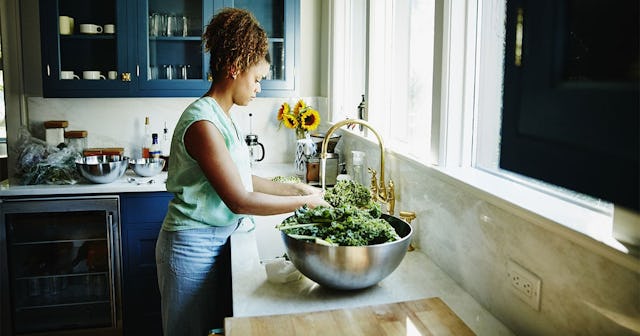'Clean Eating' Is A Classist, Fat-Shaming Social Media Trend

We’ve all heard the term “clean eating,” and how it’s supposed to make us thinner, healthier, and more energetic. According to Healthline, it focuses on eating foods that are processed as little as possible, in as close to their natural form as possible. You also prepare more of your meals at home, to ensure that “little as possible” processing. This explanation is followed by a bucolic photo of a woman in a farmhouse kitchen, chopping yummy berries into perfect slices.
https://www.instagram.com/p/B9mIIseJFHh/?utm_source=ig_web_button_share_sheet
I’m calling bullshit. “Clean eating” is actually a classist social media trend that feeds into the worst of diet subculture. Cooking Light says that in order to eat clean, your foods need to be as fresh as possible (with, they say in all seriousness, the possible exception of frozen green beans). Eliminate processed foods, or anything that comes “in a box, bag, can, or package.” You need to up your intake of whole grains like “brown rice, millet, amaranth, and quinoa” (WTF is amaranth?!). You can also have “clean sugar” like “honey, maple syrup, and dehydrated sugar cane juice.” Oh, and eat 5-6 meals a day.
Problem number one: all your food needs to be fresh. But what if you live in a food desert and your only access to a grocery store comes in the form of a corner store? They don’t sell produce or lean meat, and when they do, it tends to be astronomically expensive. Clean eating comes with an automatic presumption of access. You can click on Instagram and see the pretty pictures, can’t you? Well, then, why can’t you get your ass down to the farmer’s market and buy yourself some organic, local veggies?
Maybe you don’t own a car.
Maybe it’s too far to walk.
Maybe your spouse has the car.
Maybe you don’t have the money.
Maybe you are on a tight budget, and processed food is cheaper.
Want to stretch your food dollar? Don’t stuff your cart with perishable fruits and veggies. Double-down on the canned stuff, the boxed stuff, the two-for-one specials on tuna and Rice-a-Roni. You can feed kids on macaroni and cheese and peanut butter and jelly sandwiches a hell of a lot cheaper than you can feed them on quinoa salad with chopped strawberries (good luck finding those at an affordable price point). Clean eating assumes you’re shopping at Whole Foods with a platinum card, not at Piggly-Wiggly with your coupons and/or SNAP benefits.
Clean eating also presumes you have the access to cooking space, utensils, and know-how. This sounds stupid. Of course everyone has access to this stuff, right? But remember that time you were making cookies when you first got married and realized you didn’t have a cookie sheet? You just went out and bought one, right? Imagine you didn’t have the money. Or think about the first time you made soup. You needed one of those giant-ass pots. Guess what? A lot of Americans don’t have those. And if they do, they don’t have a skimmer, a meat thermometer, a fancy blender, a mixer or any of those other items clean eating recipes seem to require (and take for granted).
My mother owned one colander. One. It was yellow and plastic. We didn’t have the storehouse of Tupperware or glassware in which to store prepared breakfast meals and salads. And we weren’t even poor.
Imagine that you have the cash to drop on this food. You can buy the quinoa. You can buy the amaranth. You even know how to cook it, because you either googled the hell out of it or possess some ancestral knowledge passed down from your crunchy forebears. Clean eating also presumes you have time, in the midst of children’s lost shoes and homework and soccer games and laundry and your full-time job, to stop. To stare at your quinoa. To properly soak your beans. To chop your strawberries. To zen out to your meals, basically, while the rest of us are instant-potting cheesy chicken, or running out to McDonald’s again, or yelling that it’s nacho/taco night because we have to get food in these small people and we have to do it now.
Time is a luxury that the poor, the exhausted, and the average parent cannot afford.
You want to lose weight? Ask yourself why. Don’t presume you’d be healthier if you did so: think of your body in terms of what it can do, not how it looks, and if you can climb a mountain, then why are you worried about a few pounds?
Then refuse to be shamed into viewing certain foods as “dirty” or “clean” or “good” or “bad.” There is no good food or bad food, no clean food or dirty food. There is enough food or not enough food. Clean eating is one more fat-shaming, classist Insta-trend.
Don’t fall for it.
This article was originally published on